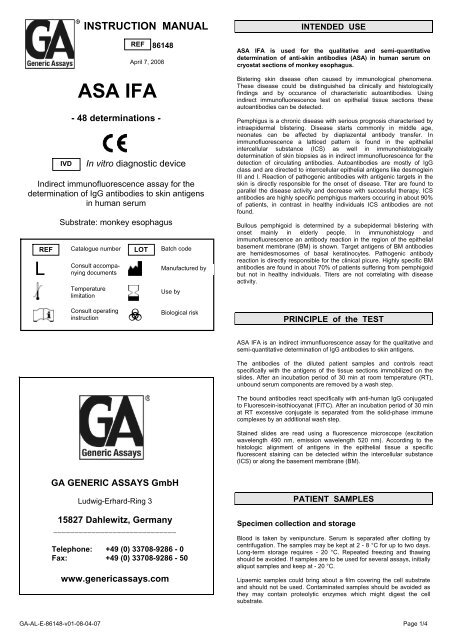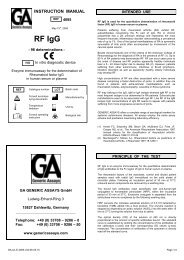ASA IFA - GA Generic Assays GmbH
ASA IFA - GA Generic Assays GmbH
ASA IFA - GA Generic Assays GmbH
- No tags were found...
Create successful ePaper yourself
Turn your PDF publications into a flip-book with our unique Google optimized e-Paper software.
INSTRUCTION MANUAL86148April 7, 2008<strong>ASA</strong> <strong>IFA</strong>- 48 determinations -In vitro diagnostic deviceIndirect immunofluorescence assay for thedetermination of IgG antibodies to skin antigensin human serumREFLIVDSubstrate: monkey esophagusCatalogue numberConsult accompanyingdocumentsTemperaturelimitationConsult operatinginstructionREFLOTDBatch codeManufactured byUse byBiological riskINTENDED USE<strong>ASA</strong> <strong>IFA</strong> is used for the qualitative and semi-quantitativedetermination of anti-skin antibodies (<strong>ASA</strong>) in human serum oncryostat sections of monkey esophagus.Bistering skin disease often caused by immunological phenomena.These disease could be distinguished ba clinically and histologicallyfindings and by occurance of characteristic autoantibodies. Usingindirect immunofluorescence test on epithelial tissue sections theseautoantibodies can be detected.Pemphigus is a chronic disease with serious prognosis characterised byintraepidermal blistering. Disease starts commonly in middle age,neonates can be affected by diaplazental antibody transfer. Inimmunofluorescence a latticed pattern is found in the epithelialintercellular substance (ICS) as well in immunohistologicallydetermination of skin biopsies as in indirect immunofluorescence for thedetection of circulating antibodies. Autoantibodies are mostly of IgGclass and are directed to interrcellular epithelial antigens like desmogleinIII and I. Reaction of pathogenic antibodies with antigenic targets in theskin is directly responsible for the onset of disease. Titer are found toparallel the disease activity and decrease with successful therapy. ICSantibodies are highly specific pemphigus markers occuring in about 90%of patients, in contrast in healthy individuals ICS antibodies are notfound.Bullous pemphigoid is determined by a subepidermal blistering withonset mainly in elderly people. In immunohistology andimmunofluorescence an antibody reaction in the region of the epithelialbasement membrane (BM) is shown. Target antigens of BM antibodiesare hemidesmosomes of basal keratinocytes. Pathogenic antibodyreaction is directly responsible for the clinical picure. Highly specific BMantibodies are found in about 70% of patients suffering from pemphigoidbut not in healthy individuals. Titers are not correlating with diseaseactivity.PRINCIPLE of the TEST<strong>ASA</strong> <strong>IFA</strong> is an indirect immunfluorescence assay for the qualitative andsemi-quantitative determination of IgG antibodies to skin antigens.The antibodies of the diluted patient samples and controls reactspecifically with the antigens of the tissue sections immobilized on theslides. After an incubation period of 30 min at room temperature (RT),unbound serum components are removed by a wash step.The bound antibodies react specifically with anti-human IgG conjugatedto Fluorescein-isothiocyanat (FITC). After an incubation period of 30 minat RT excessive conjugate is separated from the solid-phase immunecomplexes by an additional wash step.Stained slides are read using a fluorescence microscope (excitationwavelength 490 nm, emission wavelength 520 nm). According to thehistologic alignment of antigens in the epithelial tissue a specificfluorescent staining can be detected within the intercellular substance(ICS) or along the basement membrane (BM).<strong>GA</strong> GENERIC ASSAYS <strong>GmbH</strong>Ludwig-Erhard-Ring 315827 Dahlewitz, Germany_____________________________Telephone: +49 (0) 33708-9286 - 0Fax: +49 (0) 33708-9286 - 50www.genericassays.comPATIENT SAMPLESSpecimen collection and storageBlood is taken by venipuncture. Serum is separated after clotting bycentrifugation. The samples may be kept at 2 - 8 °C for up to two days.Long-term storage requires - 20 °C. Repeated freezing and thawingshould be avoided. If samples are to be used for several assays, initiallyaliquot samples and keep at - 20 °C.Lipaemic samples could bring about a film covering the cell substrateand should not be used. Contaminated samples should be avoided asthey may contain proteolytic enzymes which might digest the cellsubstrate.<strong>GA</strong>-AL-E-86148-v01-08-04-07 Page 1/4
Fluorescence intensityREADING of the RESULTSFluorescence intensity may be semi-quantitated following the guidelinesestablished by the CDC, Atlanta, USA (6):4+ = maximal fluorescence, brilliant yellow-green3+ = less brilliant yellow-green fluorescence2+ = definite but dull yellow-green fluorescence1+ = very dim subdued fluorescenceThe degree of intensity is not of clinically relevance and has only limitedvalue as an indicator of titer. Differences in microscope optics, filters andlight source may result in differences of +1 or more in intensity.Negative resultA serum dilution is considered negative for <strong>ASA</strong> if the fluorescenceintensity is less than 1+ and the tissue lacks the specific fluorescencepattern within the intercellular substance or along the basementmembrane. Tissue will appear reddish-orange due to Evans bluecounterstain.Positive resultA serum dilution is considered positive for <strong>ASA</strong> if the fluorescent stainingis at an intensity of 1+ or greater with a clearly discernable fluorescencelatticed pattern in the epithelial intercellular substance (ICS positive) or alineal pattern along the epithelial basement zone (BM positive).TitrationIf semi-quantitative titration is performed, the result should be reportedas the reciprocal of the last dilution in which 1+ apple-green fluorescentintensity with a clearly discernable staining pattern is detected.Using the recommended fourfold serial dilution the endpoint titer can beextrapolated:1:10 = 3+1:40 = 2+1:160 = +/-1:640 = - The extrapolated titer is 80.If the above mentioned quality criteria are not met, repeat the test andmake sure that the test procedure is followed correctly (incubation timesand temperatures, sample and wash buffer dilution, wash steps etc.). Incase of repeated failure of the quality criteria contact your supplier. Atroubleshoting guide is available to check laboratory procedure.Limitations of MethodAntibodies to other parts of the tissue section could lead to a respectivefluorescence pattern (e.g. cell nuclei, mitochondria, smooth musclelayer). These patterns are to be judged negative in relation to anti-skinantibodies but can indicate other autoimmune diseases.Negative results do not exclude autoimmune skin diseases ascirculating ICS or BM antibodies are not present in each patient. In caseof suspected autoimmune bullous disease but negative <strong>ASA</strong> <strong>IFA</strong> resulta biopsy sample of the patient should be checked immunohistollogicallyfor the occurance of antibody deposits within the intercellular substanceor along the basement membrane.Endpoint titer determination may vary depending on type and conditionof the fluorescence microscope used and depending on subjectivejudgement of different observers.Samples and wash solutions contaminated with bacteria or fungi couldcause unspecific staining of the cell culture substrate.Proteolytic enzymes in patient samples could result in a damage or lossof the tissue sections fixed on the slide.Any clinical diagnosis should not be based on the results of in vitrodiagnostic methods alone. Physicians are supposed to consider allclinical and laboratory findings possible to state a diagnosis.Cross-reactivityCHARACTERISTIC ASSAY DATACross-reactivity of other antibodies to the caracteristic antigen structureare unknown.Precision and ReproducibilityWith this immunofluorescence assay, no difference in the interassay andInterlot variability by using the controls could be detected.REFERENCE VALUES<strong>ASA</strong> <strong>IFA</strong>Titernegative < 10positive ≥ 10Remarks:It is recommended that each laboratory establishes its own normal andpathological <strong>ASA</strong> reference ranges for serum levels as usually done forother diagnostic parameters, too.Test validityBoth the positive and negative control provided in the test kit must beincluded in each test run. These controls must be examined prior toreading test samples and should demonstrate the following results:Negative control: The tissue should exhibit less than 1+ fluorescenceand appear reddish-orange due to the counterstain.Positive control: Fluorescence of the intercellular substance (ICS) orthe basement membrane (BM) with an intensity of 3+ to 4+.A titered positive control allows to check the test sensitivity as well asthe reactivity of the reagents and microscope optical system. Theendpoint titer stated on the label should be reproduced within onetwofold difference in titer (+/-).<strong>GA</strong>-AL-E-86148-v01-08-04-07 Page 3/4
INCUBATION SCHEME<strong>ASA</strong> <strong>IFA</strong> (86148)Dilute patient sera: screening dilution / endpoint titration using PBS solution (made of C)1 Bring all test reagents and slides to room temperature (20…25°C)ControlsPatient samples2 Dispense Controls P, N 1 - 2 drops (30 - 50 µl)Diluted patient samples 25 µl3 Incubate 30 minutes, room temperature (20…25°C)4 Rinse with PBS solution (made of C)5 Wash 2 x 5 minutes in changing PBS solution (made of C)6 Dispense Conjugate (D) 1 - 2 drops (30 - 50 µl) 1 - 2 drops (30 - 50 µl)7 Incubate 30 minutes, room temperature (20-25°C)8 Rinse with PBS solution (made of C)9 Wash 2 x 5 minutes in changing PBS solution (made of C)10 Place coverslip; 3-4 drops Mounting medium (E) per slide, lower the coverslip (G) gently11 Read using a fluorescence microscopeSAFETY PRECAUTIONS• This kit is for in vitro use only. Follow the working instructions carefully. <strong>GA</strong> GENERIC ASSAYS <strong>GmbH</strong> and its authorized distributors shallnot be liable for damages indirectly or consequentially brought about by changing or modifying the procedure indicated. The kit should beperformed by trained technical staff only.• The expiration dates stated on the respective labels are to be observed. The same relates to the stability stated for reconstituted reagents.• The substrate slides are individually covered in a sealed pouch. Do not use if pouch has been punctured.• Mixing of reagents from different kit lots and from other manufacturers could lead to differences in assay results.• Avoid time shift during pipetting of reagents.• All reagents should be kept at 2 - 8 °C before use in the original shipping container.• Some of the reagents contain small amounts of Sodium azide (< 0.1 %) as preservative. They must not be swallowed or allowed to come intocontact with skin or mucosa. Sodium azide may react with lead and copper plumbing building highly explosive metal azides. Flush with sufficientwater when disposing of reagents to prevent potential residues in plumbing.• Source materials derived from human body fluids or organs used in the preparation of this kit were tested and found negative for HBsAg andHIV as well as for HCV antibodies. However, no known test guarantees the absence of such viral agents. Therefore, handle all components andall patient samples as if potentially hazardous.• Since the kit contains potentially hazardous materials, the following precautions should be observed:- Do not smoke, eat or drink while handling kit material,- Always use protective gloves,- Never pipette material by mouth,- Wipe up spills promptly, washing the affected surface thoroughly with a decontaminant.REFERENCES1. Kumar V, Beutner EH, Chorzelski TP: Autoimmunity and the skin. Concepts Immunopathol. 1985; 1, 318-532. Chorzelski TP, von Weiss JF, Lever WF: Clinical significance of autoantibodies in pemphigus. Arch Dermatol. 1966,93, 5703. Jablonska S, et.al.: Pathogenesis of pemphigus erythematosus. Arch Dermatol. Res. 1977, 258, 1354. O'Loughlin S, Goldman GC, Provost TT: Fate of pemphigus antibody following successful therapy. Preliminary evaluation of pemphigusantibody determination to regulate therapy. Arch Dermatol. 1978, 114, 17695. Korman N: Bullous Pemphigoid. J Amer Acad Dermatol, 1987, 16, 907-286. Lyerla HC, Forrester FT: The Immunofluorescence (IF) test. In: Immunofluorescence methods in virology, USDHHS, Georgia, 1979, 71-81<strong>GA</strong>-AL-E-86148-v01-08-04-07 Page 4/4
















